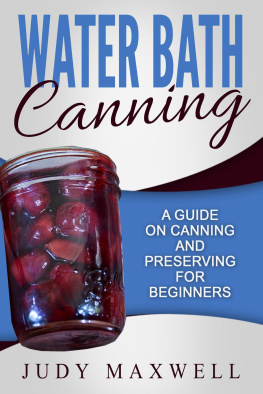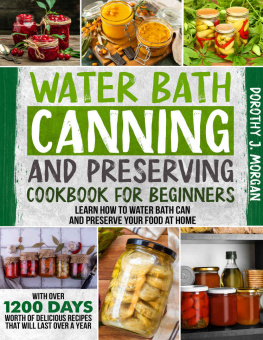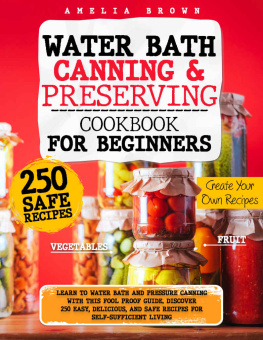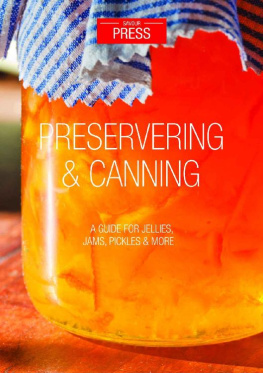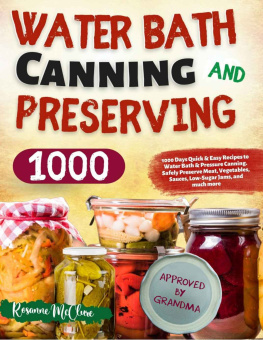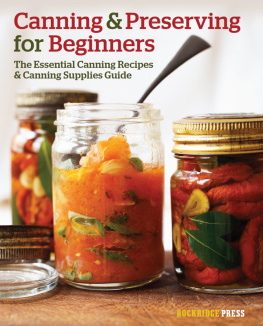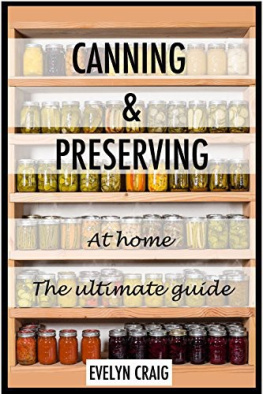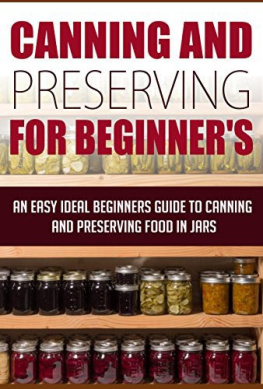Beginners Guide to Water Bath Canning
While every precaution has been taken in the preparation of this book, the publisher assumes no responsibility for errors or omissions, or for damages resulting from the use of the information contained herein.
WATER BATH CANNING: A GUIDE ON CANNING AND PRESERVING FOR BEGINNERS
First edition. March 15, 2017.
Copyright 2017 Judy Maxwell.
Written by Judy Maxwell.
10 9 8 7 6 5 4 3 2 1
Introduction
Chapter 1: Water Bath Canning 101
What is water bath canning?
The background of water bath canning
Understanding water bath canners
What are the reasons behind canning at home?
Setting up the equipment
Chapter 2: The Canning Process
Packing
Preheating the water bath
Preparing the Lids and jars
Headspace
Sealing the jars
Choosing the right processing time
Chapter 3: The General Processing Steps
How do you test the seal?
Understanding Reprocessing
Labeling and Storage
Conclusion
Introduction
T hank you for purchasing the book, Beginners Guide to Water Bath Canning .
People all over the world purchase cans from the supermarket when they can simply can the fruits and vegetables they want at home! This is surprising it is not? But, canning at home has become a tradition that every person has begun to follow. People all over the world have begun to can their food in order to stock their pantry. What if a hurricane or a tornado hits your city? What if there is a power shutdown in the entire city for a week? Would you have food in your house? You may have it for a day or two but what about the other days?
You will need to start canning at home in order to stock the food you want. You will be able to make sure that you have food in your pantry if you do not have the patience to go to the supermarket. This book contains all the information that every beginner will find essential.
You have been given the tips on how you can use water baths to can the fruits and vegetables. You will be able to store so much food at home and will be able to keep yourself fed during any situation! You have been given the process with a detailed explanation for each of the steps in the process. You will be able to store food that tastes brilliant even after a year! Make sure that the food you are planning to preserve is tasty. You will find that the food that has been preserved this way is rich in nutrients and in flavor as well.
Thank you once again. I hope you find all the information useful!
Chapter 1: Water Bath Canning 101
C anning fruits and vegetables has become a tradition that every person has begun to use over the last few years. You may have found numerous recipes online where you have been asked to use cans of fruits and vegetables to complete the dish. Did you know that you could avoid spending a lot of money on these canned products? You could simply sit at home and make them yourself! You could preserve your favorite fruits and vegetables. You will find that you do not have to spend too much money at the supermarket to procure canned foods that you will be able to consume over time. Let us first see what water canning is.
What is water bath canning?
T his is a process that is used by most people in order to store vegetables, fruits, jellies, pickles and jams at home. The cans that people use at home for water bath canning are generally large cans that do not come with any instructions. This makes it extremely difficult for a beginner to understand what he or she needs to do in order to preserve what they have chosen to. There are certain books that leave you with a lot of instructions and also provide information, but these instructions are not very simple to follow. This chapter contains information that is extremely simple to follow. You will be able to refresh your knowledge of water bath canning and home canning through this chapter.
The background of water bath canning
T his process is recommended if you are looking at preserving any food that is highly acidic. The way you will know whether or not a particular food is highly acidic or otherwise is by measuring the pH. If the pH of the food is more than 4.6, that particular food is highly acidic. If it has a pH that is either less or equal to 4.6, the acidity of the food is low. The foods that you can preserve using the water bath canning method are given below:
- Apples
- Tomatoes
- Peaches
- Pears
- Applesauce
- Apricots
- Plums
- Cherries
- Cranberries
- Rhubarbs
- Fruit juices
- Tomato puree or juice
- Jams
- Jellies
- Pickled products
When you are using the water bath canning method, you will find that the process is very simple. You will need to pack the jars with the food, completely cover the jars with water and then heat the water. The water needs to be boiled to a temperature of 100 degrees Centigrade for a period of 60 -85 minutes depending on the type of food you are trying to preserve. You will need to ensure that the oxygen in the jar has been removed from it in order to help seal the jar very tightly.
The heat that is used in this process is enough to kill all the bacterial cells that may be found in the food. It is for this very reason that you are asked to only preserve highly acidic food using this method since the acidic foods do not allow any other bacteria to form in the jars. If you find that you have been affected by some bacteria that are in the jars, you will need to consult with a doctor immediately to ensure that you are safe.
Understanding water bath canners
W ater bath canners are large pots; rather they are huge pots. They have the dimensions to hold at least 7 or 8 quart jars. The advantage of these pots is that they have the ability to immerse these quart jars by at least two inches of water.
Most often, these canners have racks and have handles as well, which make it easier to pull out the jars you are canning without hurting yourself. These cans are made of aluminum or steel, which has been covered with porcelain. Most often these jars do not have a flat bottom, which may make it difficult to use on a regular top stove. It is always good to use gas stoves when you are canning any food since you can use any kind of bottom on these stoves except for a bottom that is curved. Make sure that the canner you buy is at least four centimeters wide in diameter on every side.
You have to remember that the water bath canners are all suitable for foods that are acidic in nature. If you are trying to preserve low acidic foods it is best if you use a pressure canner. You can always use the pressure canner as a water bath canner. So, if you find yourself unable to afford two types of canners, you can purchase the pressure canner in order to ensure that you can preserve all types of food. But, if you find that the pressure canner is expensive for you, you can purchase the water canner.
What are the reasons behind canning at home?
T here are numerous reasons behind why you can start canning at home! Let us look at the best parts about canning at home.
No need of electricity!
There are vegetables that have always retained their nutrients although they have been frozen. When the vegetables need to be frozen, you will need to consume a certain amount of electricity. But, what if your city has been hit by a tornado? You will have no power and will not be able to store vegetables and the ones that you have frozen become spoilt very quickly. But, when it comes to canning, you do not have to worry too much about how you will be able to store the vegetables or even process the food.
No water source required
Next page
